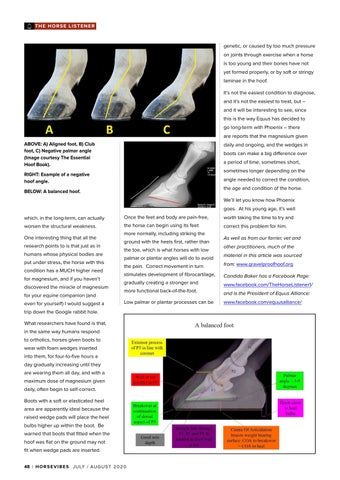THE HORSE LISTENER
genetic, or caused by too much pressure on joints through exercise when a horse is too young and their bones have not yet formed properly, or by soft or stringy laminae in the hoof. It’s not the easiest condition to diagnose, and it’s not the easiest to treat, but – and it will be interesting to see, since this is the way Equus has decided to go long-term with Phoenix – there are reports that the magnesium given ABOVE: A) Aligned foot, B) Club foot, C) Negative palmar angle (Image courtesy The Essential Hoof Book).
daily and ongoing, and the wedges in boots can make a big difference over a period of time, sometimes short, sometimes longer depending on the
RIGHT: Example of a negative hoof angle.
angle needed to correct the condition, the age and condition of the horse.
BELOW: A balanced hoof.
We’ll let you know how Phoenix goes. At his young age, it’s well which, in the long-term, can actually
Once the feet and body are pain-free,
worth taking the time to try and
worsen the structural weakness.
the horse can begin using its feet
correct this problem for him.
One interesting thing that all the research points to is that just as in humans whose physical bodies are put under stress, the horse with this condition has a MUCH higher need for magnesium, and if you haven’t discovered the miracle of magnesium for your equine companion (and even for yourself) I would suggest a
more normally, including striking the ground with the heels first, rather than the toe, which is what horses with low palmar or plantar angles will do to avoid
As well as from our farrier, vet and other practitioners, much of the material in this article was sourced
the pain. Correct movement in turn
from: www.gravelproofhoof.org
stimulates development of fibrocartilage,
Candida Baker has a Facebook Page:
gradually creating a stronger and more functional back-of-the-foot. Low palmar or plantar processes can be
trip down the Google rabbit hole. What researchers have found is that, in the same way humans respond to orthotics, horses given boots to wear with foam wedges inserted into them, for four-to-five hours a day gradually increasing until they are wearing them all day, and with a maximum dose of magnesium given daily, often begin to self-correct. Boots with a soft or elasticated heel area are apparently ideal because the raised wedge pads will place the heel bulbs higher up within the boot. Be warned that boots that fitted when the hoof was flat on the ground may not fit when wedge pads are inserted. 48 | H O R S E V I B E S J U LY / A U G U S T 2 0 2 0
www.facebook.com/TheHorseListener1/ and is the President of Equus Alliance: www.facebook.com/equusalliance/



















